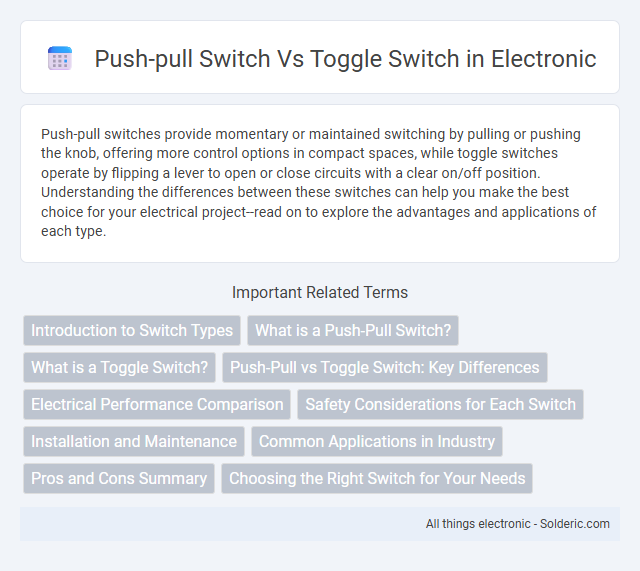Push-pull switches provide momentary or maintained switching by pulling or pushing the knob, offering more control options in compact spaces, while toggle switches operate by flipping a lever to open or close circuits with a clear on/off position. Understanding the differences between these switches can help you make the best choice for your electrical project--read on to explore the advantages and applications of each type.
Comparison Table
| Feature | Push-Pull Switch | Toggle Switch |
|---|---|---|
| Operation | Activated by pushing or pulling the knob | Flipped or toggled up and down or side to side |
| Common Uses | Guitar electronics, automotive controls | Lighting, power control, electronics |
| Switch Positions | Usually two positions: push and pull | Two or more stable positions |
| Installation | Panel-mounted, requires knob clearance | Panel or PCB mounted, compact form |
| Durability | Moderate mechanical wear with use | High durability, robust mechanical design |
| Applications | Switching circuit paths, changing modes | Power switching, mode selection |
| Size | Bulkier due to knob mechanism | Typically smaller and simpler |
Introduction to Switch Types
Push-pull switches and toggle switches serve as essential components for controlling electrical circuits. Push-pull switches operate by pulling or pushing the knob to open or close a circuit, offering a secure mechanism, often used in automotive and guitar electronics. Toggle switches feature a lever that flips between positions, providing a simple and reliable on/off functionality commonly found in industrial and household applications.
What is a Push-Pull Switch?
A push-pull switch is an electrical component used to control circuits by pushing or pulling a knob to open or close the connection, commonly found in guitar wiring and automotive applications. Unlike toggle switches that flip between positions, push-pull switches provide a more compact and user-friendly design for switching between different functions or modes. Their mechanical operation offers reliable contact and easy integration into panel designs where space and ergonomics are critical.
What is a Toggle Switch?
A toggle switch is an electrical switch operated by a lever or handle that moves up and down or side to side to open or close a circuit. It is commonly used for simple on/off control in various devices and electrical systems due to its straightforward design and reliable performance. Your choice between a toggle switch and a push-pull switch depends on the desired action mechanism and the application's ergonomic requirements.
Push-Pull vs Toggle Switch: Key Differences
Push-pull switches operate by pulling or pushing the knob to open or close the circuit, commonly used in guitar controls and power tools, providing tactile feedback and precise control. Toggle switches flip between positions, typically up or down, offering quick on/off functionality favored in lighting and industrial applications. Push-pull switches offer a momentary action and compact design, while toggle switches provide a more durable, visible position indicator for long-term use.
Electrical Performance Comparison
Push-pull switches offer reliable electrical performance with low contact resistance and are ideal for circuits requiring momentary or maintained states, while toggle switches provide stable, durable connections suited for applications needing consistent on/off positions. Toggle switches typically handle higher current ratings and offer more robust mechanical endurance, making them suitable for heavy-duty electrical loads. Your choice depends on whether you need quick, user-friendly activation (push-pull) or steady, long-term switching with higher current capacity (toggle).
Safety Considerations for Each Switch
Push-pull switches offer enhanced safety by reducing accidental activation, as their design requires intentional pulling or pushing before operation, making them ideal for machinery needing secure control. Toggle switches, while easier to operate quickly, may pose a higher risk of unintended switching due to their simple flick mechanism, especially in high-vibration environments. Your choice should prioritize the specific safety demands of the application, considering how each switch's operation affects user control and incident prevention.
Installation and Maintenance
Push-pull switches offer straightforward installation with a simple mounting process, often requiring less panel space than toggle switches. Maintenance of push-pull switches is typically easier due to fewer moving parts and a design that minimizes dust and debris accumulation. Toggle switches may demand more careful wiring and periodic cleaning to ensure reliable long-term operation, especially in environments prone to dirt and moisture.
Common Applications in Industry
Push-pull switches are commonly used in industrial machinery for safety controls and emergency stop functions due to their distinct on/off tactile feedback. Toggle switches find extensive application in control panels and automation systems, providing reliable manual operation for selecting circuit modes or power states. Both switch types are essential in manufacturing environments, with push-pull favored for secure activation and toggle switches preferred for straightforward, visible status indication.
Pros and Cons Summary
Push-pull switches offer a compact design with easy on/off operation, ideal for quick control in tight spaces, but they can wear out faster due to mechanical stress. Toggle switches provide robust durability and clear visual status, making them suitable for applications requiring reliability and frequent switching, though they may take up more panel space. Choosing between these switches depends on your specific needs for space, durability, and ease of use.
Choosing the Right Switch for Your Needs
Push-pull switches offer quick on/off control with a simple pull or push action, ideal for applications requiring fast, tactile feedback, while toggle switches provide clear visual position indication and durability for frequent use in industrial or residential settings. Your choice depends on the specific operational context, such as the need for momentary contact in push-pull switches versus the stable open/closed position of toggle switches. Evaluating factors like electrical ratings, installation space, and user interaction helps ensure the right switch suits your device's performance and safety requirements.
Push-pull switch vs Toggle switch Infographic

 solderic.com
solderic.com